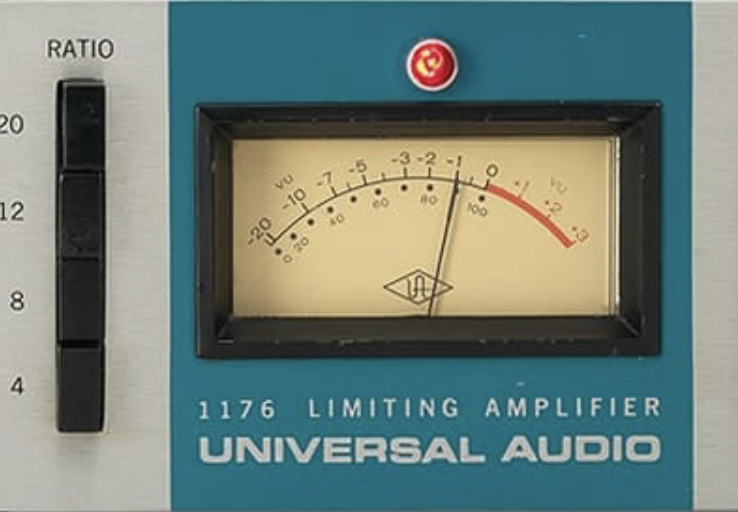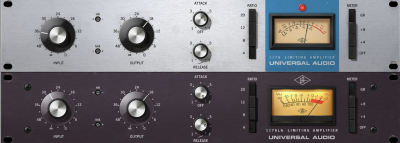The 1176 Compressor
10mins read • Bryan Clark

Jump To Section
History

We love 1176 compressors here at Blackbird. In this blog I’m going to take you on a deep dive into this iconic solid-state compressor – Universal Audio’s 1176.
Since its debut 1967, the 1176 has become a “desert island” compressor that has been a standard in the audio engineering field and been used on more records that any other compressor. Most professional studios will have multiple units in every control/tracking/mixing room. Blackbird is no exception we have over 60 of these beloved units in constant use in each of our nine studios.
The 1176 came into being after Bill Putnam Sr.’s all tube vari-mu compressor models 175 and 176. Putnam used the newly invented Field Effect Transistor (FET) technology and constructed transistorized mic preamplifier (the 1108) based off of its predecessor, the 108. This new 1176 marked a decided transition away from tube to solid state circuitry and had a spartan/modern design that eschewed standard bakelite knobs in favor of two large Input and Output knobs, two smaller Attack and Release knobs and four push-button Ratio switches. Another notable innovation was the continuously variable Attack and Release times – this was novel for compressors at the time. It was also the first compressor to have a lighting-fast attack time – a mere 20 microseconds.
Circuit Design
For those of you who are not technically inclined or have limited exposure to electronic circuit design, here’s a brief “user friendly” explanation of how the compressor works:
The 1176 is a “feedback” compressor. The signal goes through the input stage via the line input transformer. From there the signal is routed to the top of a FET (used as a variable voltage resistor). Depending on the revision of the unit (and there are many) the FET either shunts some of the input signal to ground or acts as the top leg of a voltage divider in parallel to the input of a pre-amplifier stage. The resistance between these two will cause the FET to change in response to voltage applied to the Gate lead. The FET shunts more and more audio signal to ground as compression is increased.
That’s about as much as my musician brain can handle. If you’re still hungry for more details, you can find them here.
When Universal Audio relaunched as a company, Bill Putnam Jr. set about the task of reissuing and improving upon the original 1176 designs and revisions. A significant challenge was to replicate the original output transformer with additional windings (complete with feedback) for the line output amplifier circuit. Luckily, Putnam Sr. left notes about this 1176-specific transformer so it could be recreated and improved upon.
The Nitty Gritty - Input, Output, Attack, Release and Ratios

Input
The large Input knob combines 2 of the 5 parameters for compression – Threshold and Knee. Rotating the knob clockwise increases the amount of compression.
It is certainly worth mentioning that on all 1176s the Input and Output knobs have arbitrary values that do not correlate to actual dB levels. Values range from 0 and increase in 6 degree increments to 36 then jump to 48 and then to infinity (∞).
Another note: even when the Input knob is set to ∞ (fully counter clockwise) audio signal can still pass into the processor and be compressed.
Output
The other large knob on the 1176 is Output. It determines the final output level of signal leaving the 1176. It simply makes up any gain lost through compression.
Ratio
All 1176 compressors have 4:1, 8:1, 12:1, and 20:1 ratios – a mini Fibonacci sequence if you will. The sole exception to this is the AE version (40th anniversary edition) that has 2:1, 4:1, 8:1, and 20:1 ratio buttons.
There are also other non-intended (but certainly useful) 2-button ratio settings (4:1- 8:1, 8:1- 12:1, 12:1- 20:1), three 3-button settings (4:1-8:1-12:1, and 8:1,12:1,20:1), and the famous “all-in” setting that uses all four ratio settings depressed simultaneously.
Attack
Attack sets the varying amount of time it takes the 1176 to respond to an incoming signal and begin gain reduction. The 1176’s attack time ranges from 20 microseconds to 800 microseconds. If you bypass the compression circuit (by rotating the Attack knob fully counter clockwise and switching it to the OFF position) you can use the unit as a line level amplifier for an additional 45 dB of gain.
Release
Release times are adjustable from 50 milliseconds to 1100 milliseconds (1.1 seconds) depending upon the revision model.
Unlike most compressors both the Attack and Release times become progressively FASTER when the knobs are turned clockwise even though the numbers are increasing (from 1 to 7).
This is a bit counterintuitive as is the values: 1 to 7. I always like to joke that you could replace the Attack and Release time numbers with fruit icons and still get just as good results. Or even replace 1 with a tortoise, and 7 with a hare. Regardless, remember that both Attack and Release times are fastest when fully clockwise and slowest when fully in the counter-clockwise position.
Revisions, Revisions, Revisions

The 1176 has gone through many revisions since its debut. What follows is a brief chronology of most of them. Visually there are three easily identifiable revisions: blue stripe, blackface, and silver-face units. Each of these have multiple revisions within them.
Bluestripe
rev A (first produced on June 20, 1967, serial numbers 101-125)
rev AB (Nov. 1967, serial numbers 126-216)
rev B (Nov. 1967 to Jan. 1970, serial numbers 217-1078)
All of these are blue stripe 1176s. The Blue stripe 1176s have a prized reputation for providing the most grit and grime of all 1176 revisions.
Blackface
In 1970, the iconic blackface 1176 LN:
rev C (Jan. 9, 1970, serial numbers 1079-1238)
rev D (into 1973, serial numbers 1239-2331)
rev E (up to March 15, 1973, serial numbers 2332-2611)
rev F (March 15, 1973, onward, serial numbers 2612-7052),
rev G (production dates unknown, serial numbers 7053-7651).
The reason for going into these revisions is that the blackface 1176 models are by far the most common and widely used. This is especially true for rev E and F models. The main difference between these two is that rev F’s output amplifier was changed from the original Class-A design to a push-pull configuration (based on the 1109 preamp) that provides more output drive.
Of all of those revisions C, D and E are generally the most desirable. And in fact in April 2000 when Universal Audio started to re-create this classic compressor, the circuitry that they used as inspiration drew from rev C, D and E (which has a switchable output transformer).
Silverface
rev H (production dates unknown, serial numbers 7652 and above)
40th Anniversary Edition
rev AE One special revision is the 1176 AE which is the 40th anniversary edition. It has a lot of exclusive mods including a 2:1 compression ratio button.
Plugin Versions

Universal Audio also offers a plugin version of three classic 1176 models: the blue stripe, blackface, and AE edition. They’ve also packed in some modern features not possible on the original analog versions:
Headroom (HR)
Headroom allows the user to adjust the internal operating reference level for the plug-in so that there is more choice of when or how much the plug-in can be pushed into gain reduction and/or distortion.
Mix
This will allow you to achieve parallel compression by blending the output balance between the processed and unprocessed signal without having to create additional routings in the DAW.
Fully counterclockwise: only the unprocessed source material is output. Fully clockwise: only the processed signal is output. The mix is continuously variable and phase accurate throughout the control range.
Sidechain Filter
UA has also made a fixed 3 dB per octave custom linear filter for the compressor’s sidechain. This allows the bass frequencies to become less likely to trigger compression resulting in a “punchier” low end by reducing excessive compression and/or “pumping” on bass-heavy audio signals.
This can be toggled off and on by clicking the “/” filter symbol and/or “RELEASE” text label beneath the Release knob. When active, the Release knob is “lifted” and slightly enlarged.
Wrapping Up
I hope you were able to gain some valuable knowledge and insight into arguably the most famous compressor ever made – the 1176. To learn more about compressors I invite you to watch our insideblackbird.com series on compressors. Until next time be safe and be well.


